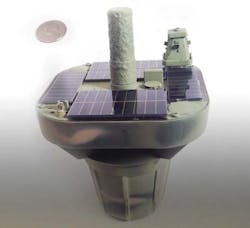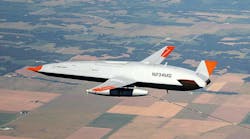Officials of the Air Force Life Cycle Management Center at Wright-Patterson Air Force Base, Ohio, announce a potential $24.5 million contract to Physical Optics Wednesday for continued development of small hand-laced or air-droppable weather stations.
Physical Optics will finalize development and begin producing the Micro Weather Sensors (MWS) and Advanced Micro Weather Sensors. This contract is a follow-on to a previous Small Business Innovation Research (SBIR) acquisition.
The Physical Optics MWS is a low-cost, lightweight, ruggedized, environmental weather station that can be deployed globally in remote locations either hand emplaced or air dropped.
It supports continuous, near-real-time weather reporting for air and parachute operations, and also includes incident meteorology for wildfire or disaster support. The system weighs less than one pound and can run for as long as 90 days on a battery charge.
Using a set of 22 integrated sensors, the MWS collects local weather data and transmits it via the Iridium satellite network to command and control elements or aircraft.
The MWS system combines a micro light direction and ranging (LIDAR) system, multi-imaging system, GPS, imaging sensors, and other weather sensors to measure temperature, pressure, humidity, wind speed and gusts, cloud ceiling, visibility, orientation, global position, precipitation type, precipitation amount, and lightning activity.
Additionally, it calculates dew point, pressure altitude, density altitude, and altimeter setting, and takes 360-degree camera images of the surrounding area.
The Physical Optics Advanced Micro Weather Sensor brings weather sensor miniature one step farther. It will weigh no more than 3.18 ounces will measure temperature, dew point, pressure altitude, barometric pressure, density altitude, wind velocity, wind direction, cloud height, and visibility.
The system will be as accurate as current larger fielded systems but packaged small enough to fly on micro unmanned aerial vehicle (UAV) or operate in hand held modes.
Its data output will comply with a user-defined XML and graphical user interface, and will enable human overrides to the data for increased accuracy. The system will be powered off of low-power DC power sources that are suitable for field and tactical use.
On this contract Physical Optics engineers will handle non-recurring engineering, production readiness, and build two Micro Weather Sensor test units and two Advanced Micro Weather Sensors. Physical Optics will do the work in Torrance, Calif., and should be finished by November 2021.
For more information contact Physical Optics online at www.poc.com, or the Air Force Life Cycle Management Center at www.wpafb.af.mil/aflcmc.
Learn more: search the Aerospace & Defense Buyer's Guide for companies, new products, press releases, and videos



